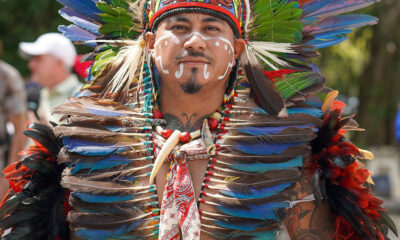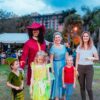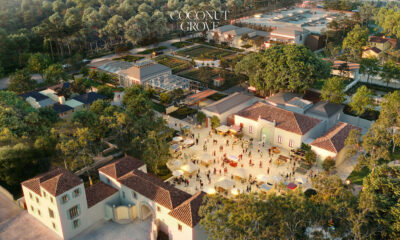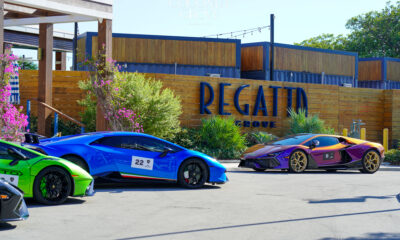Community
Vizcaya Museum and Gardens Announces Landmark $20 Million Gift from Ken Griffin and Extraordinary Opportunity to Provide Public Access to Historic Villa Serena in Vizcaya Village
Historic commitment accelerates Vizcaya’s vision to revitalize Vizcaya Village and could open Villa Serena to the public for the first time in 111 years
Vizcaya Museum and Gardens today announced a landmark $20 million gift from philanthropist and Citadel founder and CEO Ken Griffin, marking a defining moment in Vizcaya’s next chapter of restoration and renewal. This extraordinary commitment will support the ongoing revitalization of Vizcaya’s historic campus and jump-start the organization’s major fundraising campaign.
This remarkable gift will result in the creation of a new Center for Learning and Discovery at the Vizcaya Village. Located in the picturesque courtyard and four historic buildings that originally housed Vizcaya’s barns and stables, the Center will feature educational programming for students, families, and visitors—including hands-on artmaking and urban-agriculture experiences—galvanizing Vizcaya’s role as a cultural and community hub.
In addition to $20 million in capital support, Vizcaya and Griffin will pursue the process to relocate and open to the public Villa Serena—the 1913 home built for former U.S. Secretary of State William Jennings Bryan—along with a $5 million endowment to preserve the structure in perpetuity. The building would move to the southern portion of Vizcaya Village, in close proximity to its original site, where it would be open to the public for the first time in 111 years and help place Villa Serena in the context of local and national history. The updated master plan and the potential relocation of Villa Serena are subject to public review and approval by Miami-Dade County, the City of Miami, and other local regulatory entities.
“This is a transformative moment for Vizcaya,” said Joel Hoffman, Executive Director and CEO of Vizcaya. “Ken Griffin’s extraordinary $20 million gift will accelerate our vision for Vizcaya Village as a center for education, history, and community engagement. The potential to bring Villa Serena into that story makes this moment even more meaningful. Built just years apart by neighbors who shaped early twentieth-century America, Villa Serena and Vizcaya together provide new opportunities for public access, preservation, and civic engagement.”
“Vizcaya’s vision for a vibrant Village will connect Miami to its remarkable past and inspire what’s possible for its future,” said Ken Griffin. “Its expansion will bring history to life in new ways, sparking curiosity, creativity, and connection across our community. I’m proud to support an institution that reflects Miami’s spirit—its history, ambition, and enduring drive to create something extraordinary.”
Together, these commitments will catalyze Vizcaya’s forthcoming fundraising campaign, advancing the institution’s comprehensive master plan and funding major restoration projects, while supporting plans that could establish Villa Serena as a new public amenity within Vizcaya Village—where history, education, and community come together. As South Florida’s best-known and most-visited historic house museum—with nearly 400,000 visitors annually—Vizcaya is well positioned to preserve and interpret Villa Serena for future generations.
Vizcaya’s Next Chapter
Building on substantial Miami-Dade County investments and nearly two years of master planning with renowned preservation and landscape architects Beyer Blinder Belle, Nelson Byrd Woltz, and Heritage Landscapes, Vizcaya is advancing a phased plan to:
- Restore and enhance historic buildings and landscapes within the Village,
- Expand educational and community programs for residents and visitors, and
- Reimagine Vizcaya Village as a vibrant cultural destination for Miami.
At the heart of this vision is “The Field,” a new edible garden conceived as a symbolic and programmatic focal point for the southern portion of the Village—evoking Vizcaya’s agricultural roots and inviting broader community engagement.
“Vizcaya is entering its second century with renewed purpose and ambition,” said Ken O’Keefe, Chair of the Vizcaya Museum and Gardens Trust Board of Trustees. “This commitment brings together public investment and private philanthropy to safeguard Miami’s history and accelerate the Village’s evolution as a vibrant public space for our entire community.”
Villa Serena: A Historic Gift for Miami’s Future
The opportunity to transform Villa Serena into an accessible public asset, following its long history as a private residence seen by few, is inspired by and aligned with the trajectory of Vizcaya, which was itself transformed from a private home to a community resource more than 70 years ago.
If the relocation of Villa Serena to Vizcaya Village is approved, it would be fully funded by Griffin and overseen by nationally recognized preservation architects, engineers, conservators, and contractors. The proposed relocation would move the 1913 home just blocks from its current site and integrate it at a prominent entry point to Vizcaya Village, where it would be highly visible and accessible to the public. The project would enable Vizcaya to expand its educational and cultural programming and create new public gathering spaces for social and civic exchange in the spirit of the Bryan family’s historic use of their home.
The proposed relocation would also bring together the legacies of James Deering (1859-1925) and William Jennings Bryan (1860-1925)—prominent contemporaries whose ideas, ambitions, and worldviews helped define our nation and our city. Utilizing the relocated Villa Serena, Vizcaya would provide a rigorous framework for interpreting Bryan’s multifaceted legacy—his visionary civic ideals alongside his deeply complicated views on issues such as imperialism and war, science and religion, and race relations—inviting thoughtful examination of how these tensions shaped his era and continue to resonate today.
As with all significant changes to the campus, the proposed relocation would be subject to review and approval by Miami-Dade County, the City of Miami (including its Historic and Environmental Preservation Board), and other regulatory entities. If approved, Villa Serena would become a public asset—owned by Miami-Dade County and managed by Vizcaya—ensuring its long-term preservation and public benefit.
In addition to donating the home, Griffin would also provide a separate $5 million endowment to ensure Villa Serena’s long-term care, programming, and public access—without reliance on taxpayer funding.
Together, Griffin’s $20 million gift, proposed $5 million endowment, and donation of Villa Serena—along with Vizcaya’s renewed master plan—represent a once-in-a-generation opportunity to preserve Miami’s history and create a world-class cultural campus that will serve the community for decades to come.
About Vizcaya Museum and Gardens
Vizcaya Museum and Gardens is a National Historic Landmark in Miami, originally built between 1914 and 1922 as the winter estate of James Deering. Open as a public museum since 1953, this European-inspired estate welcomes 400,000 visitors annually and includes a Main House filled with decorative arts, 10 acres of formal gardens, native forests, and mangrove shores.
On the west side of the campus, the historic Vizcaya Village, which offers a Sunday farmers market and new Village Café, is being restored to support new community programs, including urban agriculture.
Located at 3251 South Miami Avenue (with the Village across the street at 3250 South Miami Avenue), Vizcaya Museum and Gardens is open daily, except Tuesdays, from 9:30 a.m. to 4:30 p.m. and closed for Thanksgiving Day and Christmas Day. For more information, visit www.vizcaya.org.




Renderings by Beyer Blinder Belle Architects & Planners + NBW, with MAQE




























